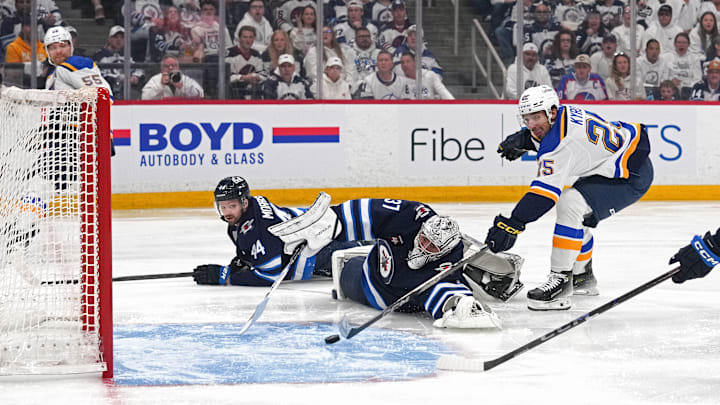Entering the third period of game 7 against the Winnipeg Jets, the Blues were up 3-1 with a chance to close out the series and extend their season into the second round of the playoffs.
The Blues then suffered an all-time collapse, allowing two goals to tie it in the final seconds of the game. They eventually would go on to lose the thriller in double overtime.
The clear weak link in the Blues' chain in this game and in other close losses was the decision-making and on-ice structure at a 6-on-5 disadvantage. With a goalie pulled, the Blues went from relentless on offense and tenacious on defense to a non-existent offense and a strained defense. The only question on Blues fans' minds: what happened?
A deliberate coaching strategy
Jim Montgomery is one of the best coaches in the league; there is no doubt about that. However, this doesn't mean his system and decisions are infallible.
Monty led the Blues to a record-setting season with new heights achieved. However, this came when they could either control the game or adapt to what was coming to them; at a clear disadvantage at 6-on-5, the Blues looked like a frantic team with little to no plan.
The default thought would be to try and score an empty net goal to ice the game, but this was not the strategy employed by Montgomery last season, and it ultimately led the Blues to heartbreak. Monty decided it was best to continually ice the puck and try and limit chances by doing so, not worrying about the empty net at all.
This bold strategy comes with the benefit of stopping a 6-on-5 offense when it works, but it does keep the game in reach for the other team to score in the final seconds. This is exactly what played out in that heartbreaking loss.
Adapting for the future
In the year-end press conference, Jim Montgomery specifically cited the 6-on-5 play as something he would be updating his strategy on and finding a better way to adapt and react to what is working around the league.
Monty clearly acknowledged his mistake and wanted to make a better effort to close out games at a man disadvantage, and said he would be looking around the league at what successful teams do so that he and the Blues could try and emulate them.
What is most successful is trying to put the game out of reach with an empty net goal and ice the game rather than ice the puck. Jim Montgomery's hockey is a very aggressive, high-intensity style of hockey, and I would expect this message and play style to shine through even at a man disadvantage, such as during the 6-on-5 play.
This falls in line with Montgomery's background and specialty with the Blues. During his first tenure in St. Louis, he served as an assistant coach and as overseer of the penalty kill, which shone during his first run as assistant coach. This gives hope and light to the fact that Monty knows how to run a playbook during a man disadvantage period, and should have all the tools to get the team where they want to be to prevent any more heartbreaking losses late at 6-on-5.
